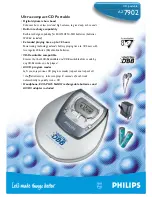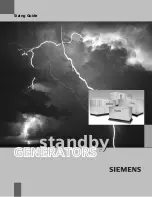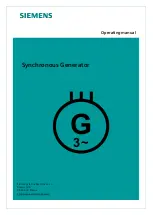
“V-TYPE” PREPACKAGED
TRANSFER SWITCHES
SECTION 3.4
DIAGNOSTIC TESTS
PART 3
Page 51
current (AC) is changed to direct current (DC) by a
bridge rectifier before reaching the closing coil. This
test will determine if standby voltage is available to
the closing coil.
If normal standby source voltage is available to the
terminals of the standby closing coil but transfer to
“Standby” does not occur, look for (a) binding or stick-
ing in the transfer mechanism, (b) a defective coil, or
(c) a bad bridge rectifier. The coil and the bridge recti-
fier must be replaced as a unit.
PROCEDURE:
1. If necessary, repeat Step 2 under “Procedure” of Test 1.
The system must be in automatic operating mode, with
engine running, and standby source voltage available to
Terminal Lugs E1 and E2.
2. On the standby closing coil, locate the two terminals to
which Wires E1 and E2 connect (Figure 1). Use an accu-
rate AC voltmeter (or a VOM) to check the voltage across
these two terminals. Generator line-to-line voltage must
be indicated.
RESULTS:
1. If generator line-to-line voltage is indicated and transfer to
“Standby” occurs, discontinue tests.
2. If generator line-to-line voltage is indicated but transfer
does NOT occur, go to Test 4.
3. If generator line-to-line voltage is NOT indicated, go to
Test 3.
TEST 3- TEST TRANSFER RELAY TR
DISCUSSION:
In automatic operating mode, the transfer relay must
be energized by control board action or standby
source power will not be available to the standby
closing coil. Without standby source power, the clos-
ing coil will remain de-energized and transfer to
“Standby” will not occur. This test will determine if the
transfer relay is functioning normally.
PROCEDURE:
1. See Figure 2. Disconnect all wires from the transfer relay,
to prevent interaction.
2. Set a VOM to its “Rx1” scale and zero the meter.
3. Connect the VOM test leads across relay terminals 6 and 9
with the relay de-energized. The VOM should read INFINITY.
4. Connect the positive (+) post of a 12 volt battery to Relay
Terminal “A” and the negative (-) battery post to Relay
Terminal “B”. The relay should energize and the VOM
should read CONTINUITY.
5. Now, connect the VOM test leads across Relay Terminals
1 and 7.
a. Energize the relay and the meter should indi-
cate INFINITY.
b. De-energize the relay and the VOM should read
CONTINUITY.
RESULTS:
1. Replace transfer relay if it is defective.
2. If transfer relay checks good go to Test 5.
Figure 2. Transfer Relay Test Points
TEST 4- CHECK MANUAL TRANSFER SWITCH
OPERATION
DISCUSSION:
In automatic operating mode, when utility source volt-
age drops below a preset level, the engine should
crank and start. On engine startup, an “engine warm-
up timer” on the generator’s control board should start
timing. When that timer has timed out (about 15 sec-
onds), the transfer relay should energize to deliver
utility source power to the standby closing coil termi-
nals. If normal utility source voltage is available to the
standby closing coil terminals, but transfer to
“Standby” does not occur, the cause of the failure
may be (a) a failed standby closing coil and/or bridge
rectifier, or (b) a seized or sticking actuating coil or
load contact. This test will help you evaluate whether
any sticking or binding is present in the transfer
mechanism.
7
A
B
4
9
6
1
126
N1A
194
23
E2
205
3
CONNECT VOM
DESIRED METER READING
TEST LEADS ACROSS
ENERGIZED
DE-ENERGIZED
Terminals 6 and 9
Continuity
Infinity
Terminals 1 and 7
Infinity
Continuity
Summary of Contents for 4721
Page 60: ...PART 3 Page 56 V TYPE PREPACKAGED TRANSFER SWITCHES SECTION 3 4 DIAGNOSTIC TESTS...
Page 98: ...PART 4 Page 94 DC CONTROL LIQUID COOLED ENGINE UNITS SECTION 4 4 DIAGNOSTIC TESTS...
Page 112: ...PART 9 Page 108 ELECTRICAL DATA WIRING DIAGRAM 1 5 LITER LIQUID COOLED ENGINE DRAWING 0E0343 B...
Page 115: ......
















































